Red banana
| Musa acuminata | |
|---|---|

Red banana plant from Tanzania showing fruits and inflorescence.
|
|
| Species | Musa acuminata |
| Cultivar group | AAA Group (Cavendish group) |
| Origin | West Indies and Central America |
Red bananas are a group of varieties of banana with reddish-purple skin. Some are smaller and plumper than the common Cavendish banana, others much larger. When ripe, raw red bananas have a flesh that is cream to light pink in color. They are also softer and sweeter than the yellow Cavendish varieties, some with a slight mango flavour, others with an earthy flavour. Many red bananas are exported by producers in East Africa, Asia, South America and the United Arab Emirates. They are a favorite in Central America but are sold throughout the world.
The red banana is a triploid cultivar of the wild banana Musa acuminata, belonging to the Cavendish group (AAA).
Its official designation is Musa acuminata (AAA Group).
Synonyms include:
It is known in English as red Dacca, red banana, Claret banana, Cavendish banana "Cuban Red", Jamaican red banana, and red Cavendish banana. It is also known under a variety of common names in other countries, including the following:
Red bananas should have a deep red or maroon rind when ripe, and are best eaten when unbruised and slightly soft. This variety contains more beta carotene and vitamin C than yellow banana. It also contains potassium and iron. The redder the fruit, the more carotene and the higher the vitamin C level. As with yellow bananas, red bananas will ripen in a few days at room temperature and are best stored outside refrigeration.
Red bananas are eaten in the same way as yellow bananas, by peeling the fruit before eating. They are frequently eaten raw, whole or chopped, and added to desserts and fruit salads, but can also be baked, fried, and toasted. Red bananas are also commonly sold dried in stores.
The red banana has more beta carotene and vitamin C than yellow banana varieties. All bananas contain three natural sources of sugar: sucrose, fructose, and glucose, making them a source of instant and sustainable energy.
The first bananas to appear on the market in Toronto (in the 1870s and 1880s) were red bananas. Red bananas are available year round at specialty markets and larger supermarkets in the United States.
...
Wikipedia
